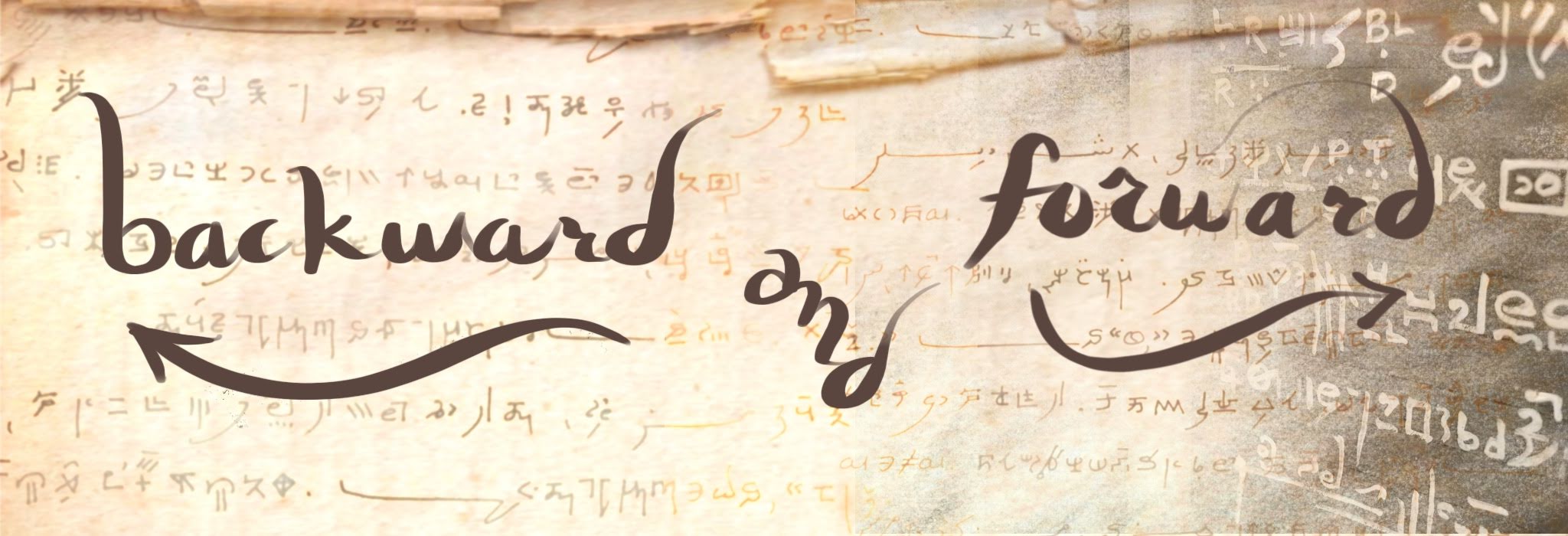dictionary of Backward script
“Who brought the dessert?”
In the sample above, there are 4 words composing the sentence. I have written the same sentence forwards, then backwards to show how the look changes. Two of the words have backward forms, WHO and THE. Notice how the arm WHO extends the whole length of the sentence, carrying the other 3 words. The second backward word is the pin THE which pierces the arm.
You can write the word THE as an arm as well. You can also write the word WHO as a pin. The above example shows the standard and perhaps most logical way to do it, however variations are up to the person writing.
Tapissary is read forward on one line, then backward on the next line down, repeating this snaking process all the way to the bottom of the text. For the backward lines (reading right to left), there are around 130 vocabulary words which have an additional backward form, in essence telling you to read this line right to left. It looks like extended arms making themselves obvious, like arrows pointing the direction in which to read. Only some of the most common words have this special right to left form because their frequency of use almost guarantees that there will be at least one ‘arrow’ on a given line of text.
For each word listed in this dictionary of backward script, I have also included the forward script form, and the pronunciation of the word (please click the SPEECH tab for help with the pronunciation). Notice that most backward glyphs have two forms: the pin and the arm. The arm, which is an extended glyph can be made long enough to carry a whole phrase within its reach, or you can keep it short if you wish. When you write the arm with its long extension you place the other words above that arm. In essence, it kind of looks like it hugs the added vocabulary. The best way to choose how much vocabulary to include in an arm is to consider short phrases, such as prepositional phrases and simple subject-object phrases. Examples…. “to the house”, “who has a good idea?”. The pin form of the backward glyph is used when you wish to add a backward glyph within an arm you have already written. Notice that the pins in the dictionary show their form piercing a straight line. This straight line signifies an arm, and how the pin looks when piercing it. See the example above where the pin THE, pierces the arm WHO. Some pins in the dictionary are shown independent of a horizontal base line, or in other words, can function without an arm. But there is flexibility in backward writing – breaking the rules is up to your sense of aesthetics. You can use only pins without any arms present, or vice versa, or combine them to your liking. Keep in mind that the function of backward glyphs is to easily signal in which direction to read the line. You don’t need a pile of pins piercing countless arms. One arm with the addition of possibly one or two pins is plenty to send the message. That said, the writer is free to use as many or few as he or she desires, it may be that you wish to compose rather complex knots of script. In fact, you don’t even have to use arms or pins at all if they bother you, however, it would be a real headache trying to figure out in the middle of a page in which direction to read. You would have to read a few words each time to gauge the correct direction. In the mid 1990’s when I brought forward and backward writing to Tapissary, the backward forms were few and very subtle and took a little effort to determine in which direction to read a certain line in a text. The wild forms that developed later put an end to the guess work. Toward the year 2000, some of the backward forms became overly complex squiggles. You may notice many of the words in the dictionary have more than one backward form. This is due to the history of the word, some of the old forms are still retained, but simpler versions are more modern, still effective, and easier to write. Again, it’s the choice of the user.
To see the beginner’s dictionary of 900 forward glyphs, click on the dictionary tab.
Note above, for the word SOMETHING, you will see the numbers 1 and 2 to the right. This is the stroke order. It makes it easier to start with stroke one, then write stroke 2 above it. Stroke 3 is squeezed between 1 and 2. Stroke 4 is the furthest to the left which ends in the long horizontal line. The numbers are shown only as an instruction, they are not written as part of the glyph.
